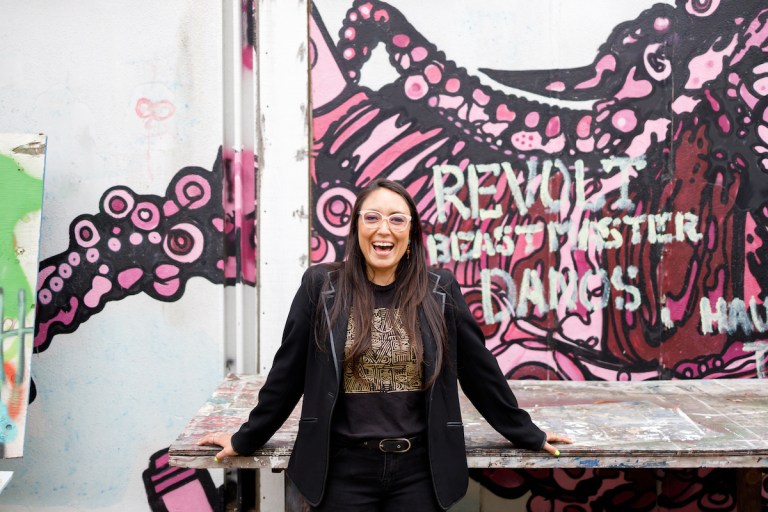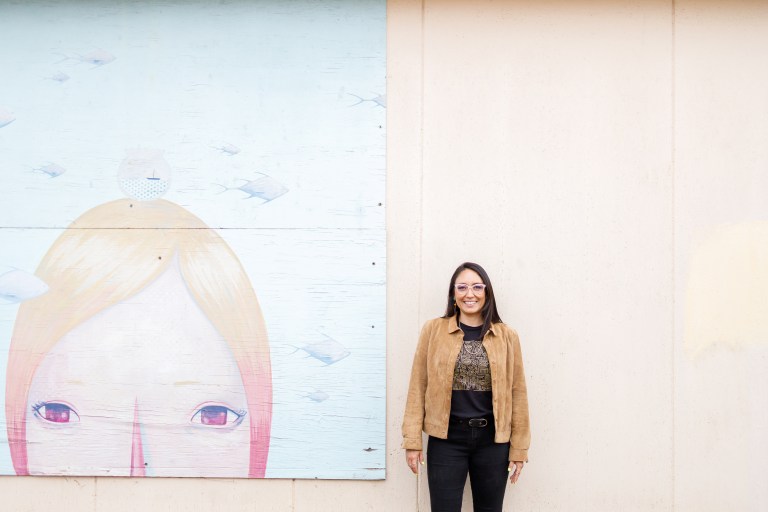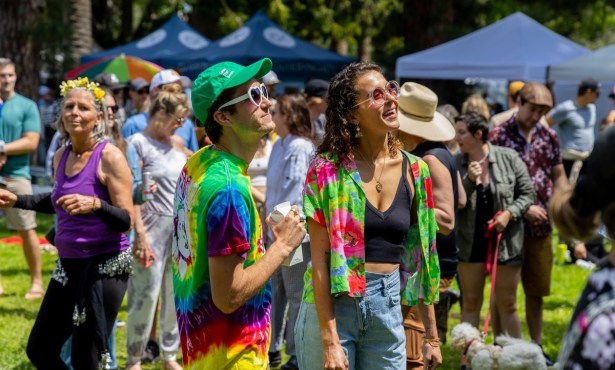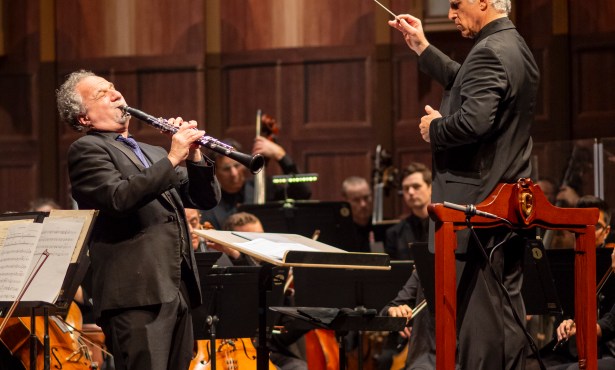I Madonnari Comes Back to Move Forward
Santa Barbara’s Beloved Street-Painting Festival Returns to the Mission Refreshed
By Charles Donelan | May 26th, 2022

When the annual I Madonnari street-painting festival returns to the Old Mission this weekend after two years of operating online, participants and attendees will celebrate more than just la dolce vita, Santa Barbara–style. From its beginning, this iconic expression of collective effervescence has had its roots in the year-round activities of the Children’s Creative Project (CCP), an enduring and influential public-private partnership dedicated to bringing the arts and artists into Central Coast schools. The founder of I Madonnari, Kathy Koury, was also the executive director of the Children’s Creative Project for 44 years. CCP’s new director, Kai Tepper, inherits a much-cherished community event and an organization that exemplifies the public spirit of our city and region.
Held on the plaza in front of the Mission Santa Barbara, I Madonnari takes place over the three days of Memorial Day weekend. The organizers divide the asphalt in front of the Mission into 130 squares. On Saturday morning, participating artists arrive with supplies and receive colored chalk, ready to realize their visions for their piece of the festival’s giant mosaic. Original designs, copies of Renaissance masterpieces, and everything in between take shape over the next 72 hours as the artists lie, sit, and kneel on their asphalt canvases, sketching and shading their creations. In the surrounding area, vendors offer fresh food and cold beverages to a crowd of friends and onlookers. With the Mission as a backdrop in one direction and the Channel Islands in the other, it’s as picturesque as anything in Santa Barbara — which says a lot.
Behind all the fun and beauty of this special holiday weekend event lies a host of fascinating and influential factors that give depth and consequence to the sheer pleasure of the scene. When the event was founded by Koury in 1987, it was the first such festival dedicated to the art of street painting in the Western Hemisphere and Mexico. Based on a similar festival in the small Italian city of Grazie di Curtatone, I Madonnari offers a modern California take on a tradition that dates back to the 16th century. Sponsorships for the artworks fund the CCP, which has served hundreds of schools and tens of thousands of children for more than four decades.

The festival quickly set off a chain reaction that spread all over North America and Mexico. There are now dozens of such festivals everywhere, from Provo to Austin and Denver to Puerto Vallarta.
This year is different for several reasons. First, it represents the resumption of the event at its original location on the Mission plaza. It’s also the first year under new leadership, with Tepper now serving as executive director following Koury’s retirement. Finally, for the first time, the festival will host a workshop on Saturday called “The Art of Mass Gatherings.”
This experiential learning opportunity offers artists, event planners, emergency first responders, and interested citizens a chance to learn about the latest thinking regarding the safety, sustainability, access, and community of public events. As we shall see, the timing, vision, and scope of this initiative reflect a new mindset regarding festivals and emergency preparedness, the formation of community, and the role of the arts in public life.
I Madonnari Origins
Kathy Koury grew up in Santa Barbara. She attended public schools and graduated from Santa Barbara High. She first heard about the annual street painting event in Grazie di Curtatone in 1986 from the photographer Jesse Alexander. He showed Koury some photographs and suggested that she head to Italy to see it in person.
She came back with the idea that this might be something that could work here and almost immediately ran into a neighbor who was on the Old Mission bicentennial celebration committee. Koury arrived at the committee’s next meeting, snapshots of the Italian street painting festival in hand, and told Father Virgil Cordano and the rest of the group, “I have an idea.” Fifteen minutes later, the committee said yes. Father Virgil even accepted Koury’s observation that the plaza would need resurfacing with fresh asphalt. “We were going to make some improvements anyway,” he conceded, and he gave I Madonnari the green light.
At that time, Koury had already served several years as director of the Children’s Creative Project. She conceived and implemented the idea of businesses, organizations, and individuals sponsoring the squares to raise money for the organization. Building from an original all-volunteer program at Franklin School, and with the help of legendary schools leader Bill Cirone, the CCP expanded, year after year, until it was in more than 100 schools serving 50,000 students throughout Santa Barbara and San Luis Obispo counties.

Visual and performing arts programs proliferated, and the CCP served as a hub for artists to network and develop relationships with schools. Koury calls Cirone “a visionary of what could happen when private and public organizations collaborate” and expresses her lasting gratitude to him and to “the Mission, the artists, the musicians, the board members, and the sponsors” who made both I Madonnari and the CCP
successful. To this day, the Children’s Creative Project maintains its unusual and powerful status as both an independent philanthropic organization and a program of the county education system.
A Storyteller in the Classroom
To get a sense of who the Children’s Creative Project supports and what that means, I spoke with storyteller Michael Katz. Katz is one of the most familiar and beloved figures in our region’s arts education ecosystem. For decades, he has traveled up and down the coast and into the valleys, delivering high-quality workshops in storytelling that children love. When I spoke with Katz by phone last week, he was finishing up a string of school visits around the Bay Area and Santa Cruz.
Katz told me that although “it’s hard to fully define what the Children’s Creative Project is” because the scope of its sponsored activities is so vast, “it’s central to what I and other artists who work with schools have done over the years.” Through the CCP’s nonprofit status, individual artists can apply for grants for which they would otherwise not be eligible. “They take care of the billing, which gives me freedom.” When a teaching artist like Katz needs help, CCP is there. Most recently, the program connected Katz to the Audacious Foundation, which sponsored his newest project, a program designed to increase mindfulness in elementary schools.
Asked to describe his work’s impact, Katz waxes enthusiastic, praising the students he encounters for being “courageous and proud” and laughing on the way to a greater sense of agency. Anyone who has seen Katz work with students knows how open-hearted and caring he is. There’s no one better at creating a safe environment where young people can be comfortable taking social risks and exploring their feelings with imagination. Katz is justifiably proud that wherever he goes, students “grow up thinking it’s normal to have a storyteller in the classroom.” After one of his workshops, children listen better and feel more confident, two critical elements in their success throughout the curriculum.
Meet the Chalk Artists
As the earliest and best-known street-painting event in this country, I Madonnari attracts top talent. Koury has always vetted the artists herself, helping them find sponsors and providing them with everything they need to create beautiful art. This year, the festival’s featured artist is Dawn Morrison Wagner, a Santa Barbara High and Cal Poly S.L.O. graduate who lives in Thousand Oaks.
Wagner gets a big 12-by-12-foot square in a prominent spot on the plaza. She earned the title in 2020, but thanks to COVID-19, she had to wait to draw at the Mission again. She’s sticking with the design she had in mind two years ago, a composition of multiple images incorporating aspects of her previous work and celebrating 35 years of past festivals.
Having continued to draw in her driveway at home through the pandemic, Wagner looks forward to being back on the plaza, where she can talk to people and connect with other artists. “I came to a stark realization last year,” she told me. “While it was great being at home because I was close to my snacks, it was too quiet! I missed the excitement and the community of being together at the Mission.”
For Sharyn Chan, another longtime regular at the festival, the appeal of the experience comes down to three things: “art, friends, and food.” Chan discovered I Madonnari in 2001 when her primary hobby was riding motorcycles. The Vespa shop in town sponsored a square, and she volunteered to help the principal artist. At first, the collaboration was chaotic, with many people involved and not enough coordination. Gradually, the others drifted away, but Chan stayed on. She’s been soloing since 2004, mainly with the larger squares. This year, she’s also going big with a 12-by-12 that will feature a dancer surrounded by roses.
“Chalk-art people are generous and giving,” she said. “They share chalk and everything else.” Asked about the heat and the physical demands of drawing on asphalt, Chan politely but firmly upended my assumptions with a different viewpoint. “Yes, it is very physical, and I have kneepads, but think of it this way — working on the ground, you’re aided by gravity. If you’re painting a mural, you’re fighting gravity. When you are working on the ground, gravity is helping you.” Chan spoke for many of the I Madonnari artists when she praised the event’s location, saying, “Being at the top of a hill makes it into a destination.” Where other street-painting festivals tend to take place in the middle of town, I Madonnari feels special because it’s perched up above, with an incredible view.
Arts Education Has Impact
After 44 years of Kathy Koury’s leadership, Kai Tepper now has the reins of the Children’s Creative Project and I Madonnari. The two women have a lot in common. They both grew up in town and graduated from Santa Barbara High School. They are both accomplished artists and passionate community organizers. Finally, when it comes to seeing the bigger picture, they are both visionaries. Koury helmed CCP through a period in which various political decisions, most prominently Proposition 13 in 1978, put funding for arts education into a state of perpetual vulnerability. When the California budget ran a surplus, like in the early 2000s, there would be money to support arts education programs, but arts education suffered when the state’s balances dipped.
For Kai Tepper, funding remains an issue, but other factors, such as climate change, pandemics, wildfires, mudslides, and questions of cultural inclusion, have come to the fore. Working in partnership with the county office of arts and culture and its head, Sarah York Rubin, Tepper hopes to position
CCP and I Madonnari as leading lights in the drive to confront these 21st-century challenges. One big step toward taking them on is “The Art of Mass Gatherings” workshop on Saturday, May 28, from 12:30 p.m.-5:30 p.m. at the Mission.

The pandemic hit the arts hard. Arts organizations had to cancel entire seasons of live events and exhibitions. Thousands of artists, performers, and support personnel were out of work for long periods. Saturday’s workshop will focus on exciting new ideas about how the art and events sector might assist with crisis management and emergency preparedness. Representatives from a national organization called Majestic Collaborations will guide the process. They work to help communities respond to humanitarian and environmental concerns with art, culture, design, and planning.
For Tepper, who was previously a director of outreach programs at the Santa Barbara Bowl and ran the Arts Fund of Santa Barbara, cultivating this new mindset represents an opportunity that our city cannot afford to miss. Looking back on the devastation caused not only by the pandemic but also by wildfires, debris flow, and drought, Tepper sees this as the right time to reimagine how we value public art and how artists participate in our community. “An arts-based approach to resilience,” she calls it, and “a new way for artists to serve the community in crisis.”
The ACE Opportunity
Think for a moment about a group of people who have already had a significant impact on everyday life in Santa Barbara: workers in Arts, Culture, and Events. Let’s call them “ACE workers.” Here are four ways to think about their potential value. First, they have transferable skills. They know how to produce safe, accessible, and sustainable live events. That means they could be helpful in other contexts that require building temporary infrastructure, managing large groups of people, and supporting people’s mental health and wellness.
Tepper points to examples of how this connection already gets made. During the wildfires, Earl Warren Showgrounds became a key location for the emergency response, sheltering large animals and providing a command post for first responders. When mudslides rendered Montecito Union School unusable, students and teachers continued learning at MOXI and the Santa Barbara Zoo. In Los Angeles, Dodger Stadium served as a giant mobile testing and vaccination center during the heaviest surges of the COVID pandemic.

As Rubin explained, this is far from an eccentric or merely local observation. It’s happening on a national level. In its National Disaster Recovery Framework, the Federal Emergency Management Agency (FEMA) cites ACE workers as key players in a whole community approach to emergency preparedness. FEMA is actively looking to artists, arts organizations, and event presenters for existing community leaders who can respond to and mitigate unexpected events. FEMA leadership believes that rooting response and recovery efforts in existing communities increases trust, values local knowledge, encourages inclusion, and enables cross-cultural communication.
What’s in it for the ACE workers? Plenty. The ACE sector is overly vulnerable to disruption — see COVID-19. ACE workers with relevant training could go to work rather than sit on the sidelines when trouble hits in future emergencies. Allowing ACE workers access to paid positions when venues are closed would save money and lives.
Finally, and perhaps most importantly, as we return to holding significant public events such as I Madonnari and Old Spanish Day s, we need to look at our community differently. Framing arts and events workers as potential leaders in preparedness and resiliency could allow us to establish a more inclusive understanding of who we are and who these events serve.
We all saw how quickly the pandemic revealed other fault lines in our national culture. Public events can serve as catalysts for social transformation, but not without analysis and understanding from today’s perspective. Optimizing our outcomes in celebration and crisis ought to be one goal, not two, and rethinking mass gatherings is a great place to start. With a better understanding of how things like I Madonnari and Old Spanish Days work, we can begin the more significant task of working together for a better Santa Barbara every day.
I Madonnari Info
At Old Mission Santa Barbara, 2100 Laguna St.; May 28-30, 10 a.m.-6 p.m. It is a free event, with live music, food, drink, and a festival items market. Small squares can be purchased for $15 for children.
The Art of Mass Gatherings Info
The Art of Mass Gatherings in Santa Barbara workshop and networking event happens Saturday, May 28, 12:30-5:30 p.m., amid the I Madonnari festival. The free event invites artists, musicians, event producers, and emergency professionals to discuss safety and sustainability of large events. See massgatheringsworkshop.




You must be logged in to post a comment.